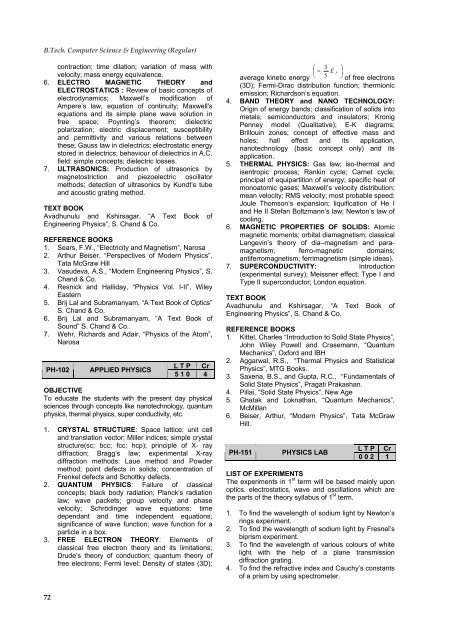B.Tech. Degree Programme Computer Science & Engineering
B.Tech. Degree Programme Computer Science & Engineering
B.Tech. Degree Programme Computer Science & Engineering
You also want an ePaper? Increase the reach of your titles
YUMPU automatically turns print PDFs into web optimized ePapers that Google loves.
B.<strong>Tech</strong>. <strong>Computer</strong> <strong>Science</strong> & <strong>Engineering</strong> (Regular)contraction; time dilation; variation of mass withvelocity; mass energy equivalence.6. ELECTRO MAGNETIC THEORY andELECTROSTATICS : Review of basic concepts ofelectrodynamics; Maxwell’s modification ofAmpere’s law, equation of continuity; Maxwell'sequations and its simple plane wave solution infree space; Poynting’s theorem; dielectricpolarization; electric displacement; susceptibilityand permittivity and various relations betweenthese; Gauss law in dielectrics; electrostatic energystored in dielectrics; behaviour of dielectrics in A.C.field: simple concepts; dielectric losses.7. ULTRASONICS: Production of ultrasonics bymagnetostriction and piezoelectric oscillatormethods; detection of ultrasonics by Kundt’s tubeand acoustic grating method.TEXT BOOKAvadhunulu and Kshirsagar, “A Text Book of<strong>Engineering</strong> Physics”, S. Chand & Co.REFERENCE BOOKS1. Sears, F.W., “Electricity and Magnetism”, Narosa2. Arthur Beiser, “Perspectives of Modern Physics”,Tata McGraw Hill3. Vasudeva, A.S., “Modern <strong>Engineering</strong> Physics”, S.Chand & Co.4. Resnick and Halliday, “Physics Vol. I-II”, WileyEastern5. Brij Lal and Subramanyam, “A Text Book of Optics”S. Chand & Co.6. Brij Lal and Subramanyam, “A Text Book ofSound” S. Chand & Co.7. Wehr, Richards and Adair, “Physics of the Atom”,NarosaPH-102APPLIED PHYSICSL T P Cr5 1 0 4OBJECTIVETo educate the students with the present day physicalsciences through concepts like nanotechnology, quantumphysics, thermal physics, super conductivity, etc.1. CRYSTAL STRUCTURE: Space lattice; unit celland translation vector; Miller indices; simple crystalstructure(sc; bcc; fcc; hcp); principle of X- raydiffraction; Bragg’s law; experimental X-raydiffraction methods: Laue method and Powdermethod; point defects in solids; concentration ofFrenkel defects and Schottky defects.2. QUANTUM PHYSICS: Failure of classicalconcepts; black body radiation; Planck’s radiationlaw; wave packets; group velocity and phasevelocity; Schrödinger wave equations: timedependant and time independent equations;significance of wave function; wave function for aparticle in a box.3. FREE ELECTRON THEORY: Elements ofclassical free electron theory and its limitations;Drude’s theory of conduction; quantum theory offree electrons; Fermi level; Density of states (3D);⎛ 3 ⎞⎜ = EF ⎟average kinetic energy ⎝ 5 ⎠ of free electrons(3D); Fermi-Dirac distribution function; thermionicemission; Richardson’s equation.4. BAND THEORY and NANO TECHNOLOGY:Origin of energy bands; classification of solids intometals; semiconductors and insulators; KronigPenney model (Qualitative); E-K diagrams;Brillouin zones; concept of effective mass andholes; hall effect and its application,nanotechnology (basic concept only) and itsapplication.5. THERMAL PHYSICS: Gas law; iso-thermal andisentropic process; Rankin cycle; Carnet cycle;principal of equipartition of energy; specific heat ofmonoatomic gases; Maxwell’s velocity distribution;mean velocity; RMS velocity; most probable speed;Joule Thomson’s expansion; liquification of He Iand He II Stefan Boltzmann’s law; Newton’s law ofcooling.6. MAGNETIC PROPERTIES OF SOLIDS: Atomicmagnetic moments; orbital diamagnetism; classicalLangevin’s theory of dia–magnetism and paramagnetism;ferro-magnetic domains;antiferromagnetism; ferrimagnetism (simple ideas).7. SUPERCONDUCTIVITY: Introduction(experimental survey); Meissner effect; Type I andType II superconductor; London equation.TEXT BOOKAvadhunulu and Kshirsagar, “A Text Book of<strong>Engineering</strong> Physics”, S. Chand & Co.REFERENCE BOOKS1. Kittel, Charles “Introduction to Solid State Physics”,John Wiley Powell and Crasemann, “QuantumMechanics”, Oxford and IBH2. Aggarwal, R.S., “Thermal Physics and StatisticalPhysics”, MTG Books.3. Saxena, B.S., and Gupta, R.C., “Fundamentals ofSolid State Physics”, Pragati Prakashan.4. Pillai, “Solid State Physics”, New Age5. Ghatak and Loknathan, “Quantum Mechanics”,McMillan6. Beiser, Arthur, “Modern Physics”, Tata McGrawHill.PH-151PHYSICS LABL T P Cr0 0 2 1LIST OF EXPERIMENTSThe experiments in 1 st term will be based mainly uponoptics, electrostatics, wave and oscillations which arethe parts of the theory syllabus of 1 st term.1. To find the wavelength of sodium light by Newton’srings experiment.2. To find the wavelength of sodium light by Fresnel’sbiprism experiment.3. To find the wavelength of various colours of whitelight with the help of a plane transmissiondiffraction grating.4. To find the refractive index and Cauchy’s constantsof a prism by using spectrometer.72
















